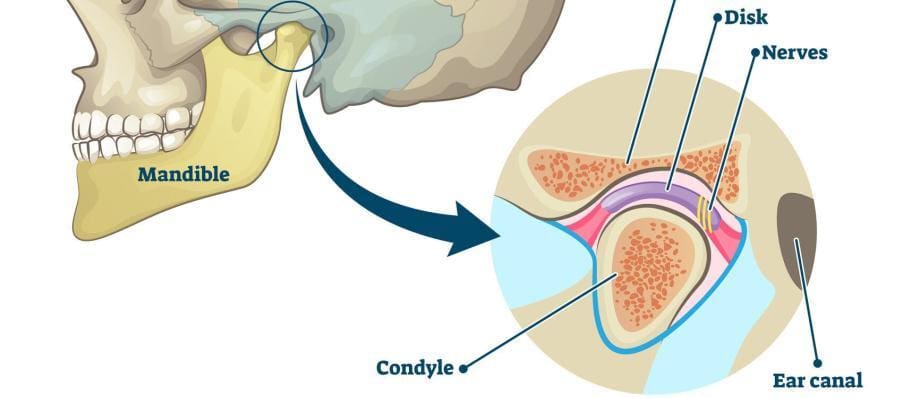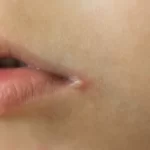Temporomandibular joint problem or TMJ disorder is a common condition that affects millions of people worldwide. The TMJ is the joint that connects the jawbone to the skull, and it is responsible for the movement of the jaw. TMJ disorder can cause a wide range of symptoms, including pain, clicking or popping sounds, difficulty chewing, and even headaches. In this article, we will discuss the causes, symptoms, diagnosis, and treatment of TMJ disorders.
What is Temporo Mandibular Joint or TMJ?
The temporomandibular joint or TMJ is the point where the lower jawbone connects to the skull. A condyle from the lower jawbone fits into a bowl-shaped compartment of the skull, which prevents these two bones from rubbing against each other during movement. Additionally, there is a disc located between the bones that acts as a cushion, preventing bone-on-bone wear. As a result, the movements of opening and closing the jaw while talking and eating are typically soundless and painless.
Causes of TMJ Disorders
The exact cause of TMJ disorders is often difficult to determine. However, there are several factors that may contribute to the development of this condition, including:
- Grinding teeth at night or during the day
- Prolonged excessive pressure on the teeth
- Irregularity of teeth
- Sleeping incorrectly on the chin in such a way that excessive pressure is applied to the jaw
- The habit of putting your hand under your chin
- Chewing very hard foods
- Incorrect tooth filling whose occlusion is not adjusted
- Premature contact at the point of the teeth
- Mental Stress and depression
- Accident and injury to the lower jaw
- Prolonged closing of the jaw Long-term
- use of certain drugs, especially corticosteroids
- Extracting teeth and not replacing them with dental implants or dental bridges
Symptoms of TMJ Disorder
The symptoms of TMJ disorder can vary from person to person. Some common symptoms include:
- Pain
- Clicking or Popping Sounds
- Limited Jaw Movement
- Headaches
- Ear Pain
Pain
Pain in the jaw, ear, neck, or face is a common symptom of TMJ disorders.
Clicking or Popping Sounds
A clicking or popping sound may be heard when opening or closing the jaw.
Limited Jaw Movement
Difficulty opening or closing the jaw or discomfort while chewing can be a symptom of TMJ disorder.
Headaches
Headaches, particularly in the temples or behind the eyes, can be a symptom of TMJ disorder.
Ear Pain
Ear pain or ringing in the ears can be a symptom of TMJ disorder.
Diagnosis of TMJ Disorders
Diagnosis of TMJ disorder typically involves a physical examination of the jaw and surrounding area. The dentist or physician will look for signs of inflammation, swelling, or muscle tenderness. X-rays or an MRI may be ordered to help diagnose the condition. In some cases, a dentist may recommend a bite test or a muscle activity test to assess the function of the jaw muscles.
Treatment of TMJ Disorder
Treatment for TMJ disorder can vary depending on the severity of the condition. Some common treatment options include:
- Medications
- Physical Therapy
- Splints or Mouthguards
- Occlusal adjustment
- Orthodontics
- Surgery
Medications
Over-the-counter pain relievers, such as ibuprofen, can help relieve pain and reduce inflammation.
Physical Therapy
Stretching and strengthening exercises for the jaw muscles can help improve the function of the TMJ.
Splints or Mouthguards
A splint or mouthguard or nightguard can help alleviate the symptoms of TMJ disorder by reducing the pressure on the TMJ.This device helps to create the necessary space in the joint and prevent the disc from being crushed between two bones.
Occlusal adjustment
Eliminating the unevenness of previous fillings and premature contacts
Orthodontics
Orthodontic treatment of teeth even in old age using invisible orthodontics, Correcting the way of closing jaws and teeth together
Surgery
In severe cases of TMJ disorder, surgery may be necessary to correct the problems.
Osteoarthritis of the jaw joint
Arthritis of the temporomandibular joint or destruction and damage of the disc of the temporomandibular joint occurs due to destructive forces or incorrect use of this joint. Due to the pressure on the joint, water is pushed out of the cells of the disc. Cells without water undergo cell death. In a normal state and at a young age, if the cause is removed, the regeneration process in the body compensates for this damage and the disc is repaired again.
In cases where we do not pay attention to this problem, the destruction overcomes the reconstruction and the disk is completely damaged and cannot be repaired anymore.
Stages of TMJ disorder
- Crepitus
- Clicking
- Destruction
Crepitus
In the early stages of the destruction of the jaw joint, crepitus or hissing or walking on snow sounds can be heard in the joint when opening and closing the mouth. This is due to the creation of a jagged surface instead of a smooth surface in the disc. The head of the jawbone moves slowly on the truncated disc, creating a hissing sound.
Clicking
The next stage of destruction of the jaw joint disc is the rupture of the disc and the person hears a clicking sound when opening and closing the mouth. Every time the head of the condyle passes over the tear, this clicking sound is created.
Destruction
In more advanced stages, the disc is removed and displaced and destructs, and as a result, the bone slides over the bone. At this stage, there is a possibility of jaw dislocation when opening the mouth or yawning.
Prevention of TMJ Disorder
Prevention of TMJ disorders involves maintaining good oral hygiene and avoiding habits that can lead to TMJ disorder, such as clenching or grinding of teeth. Stress management techniques, such as deep breathing exercises and meditation, can also help reduce tension in the jaw muscles.
It’s important to note that not all cases of TMJ disorder require medical treatment. In some cases, the symptoms may resolve on their own with rest and home care, such as applying ice packs to the affected area and avoiding hard, chewy foods. However, if the symptoms persist or worsen over time, it’s important to seek medical attention.
It’s also important to maintain regular dental check-ups and cleanings to prevent the development of dental problems that can contribute to TMJ disorders. Your dentist can assess the alignment of your teeth and recommend any necessary orthodontic treatments to correct any issues that may be contributing to your TMJ disorder.
Conclusion
TMJ disorder is a common condition that affects the joint connecting the jawbone to the skull. It can cause a wide range of symptoms, including pain, clicking or popping sounds, and difficulty chewing. The exact cause of TMJ disorders is often difficult to determine, but there are several factors that may contribute to its development. Treatment options include medication, physical therapy, splints or mouthguards, and surgery in severe cases. Prevention involves maintaining good oral hygiene, avoiding habits that can lead to TMJ disorder, and seeking medical attention if you experience any symptoms. Regular dental check-ups and cleanings can also help prevent the development of dental problems that may contribute to TMJ disorders.





